Cloudy aquarium water is right of passage in this hobby.
Almost everyone will experiences it at some point.
In this guide, I’ll walk you through the main types of cloudy aquarium water, how to fix your problem and what you can do to prevent it in the future.
Why is My Aquarium Water Cloudy?
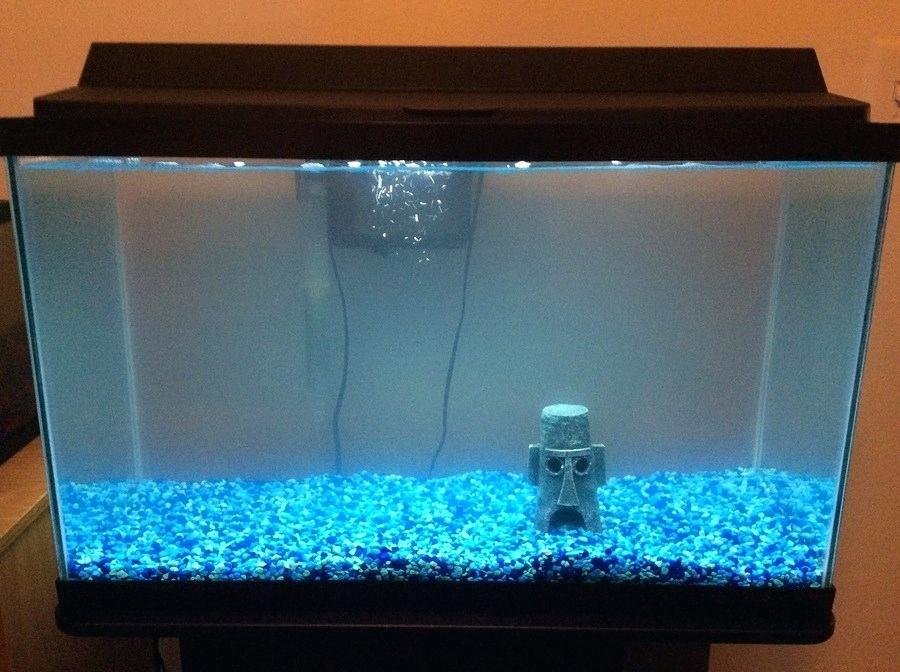
Cloudy aquarium water is a common problem, especially if your tank has been running 6 months or less.
The water might be gray or milky white, yellowish or even green.
Each color denotes a different issue going on with the aquarium, whether it’s a bacterial bloom, tannins in the water or free-floating algae.
Today I’ll go over the different kinds of cloudy aquarium water, what causes them, how you can clear up your water and how to keep it clear.
Prime Suspect: The Nitrogen Cycle
A lot of the causes of cloudy water in an aquarium are related to the nitrogen cycle. If you’re not really clear what that is, most of the explanations in this article will not make sense.
So, I’ll go over the nitrogen cycle so you have a better idea.
Nitrogen Cycle Basics
When you have fish in an aquarium, they put off waste. Fish pee and poop sinks to the bottom of the aquarium and starts to break down.
This puts off ammonia (NH3), which is bad since it’s really toxic. If enough ammonia builds up, it will start to chemically burn your fish’s gills, and they will eventually die.
Luckily, there are different kinds of good bacteria that will colonize your filters and help process fish waste.
One group of bacteria turn ammonia into nitrite (NO2 -) and another group turns the nitrite into nitrate (NO3-).
Nitrate is much less toxic than ammonia and nitrite, so it’s OK to let it build up a bit in between water changes.
Ammonia and nitrite levels at 1 ppm can stress and kill fish. In contrast, nitrates can be safely kept at as much as 40 ppm, but ideally they should be kept at 20 ppm.
See our full guide on the Nitrogen Cycle here
Does Your Tank Have White or Gray Cloudy Water?
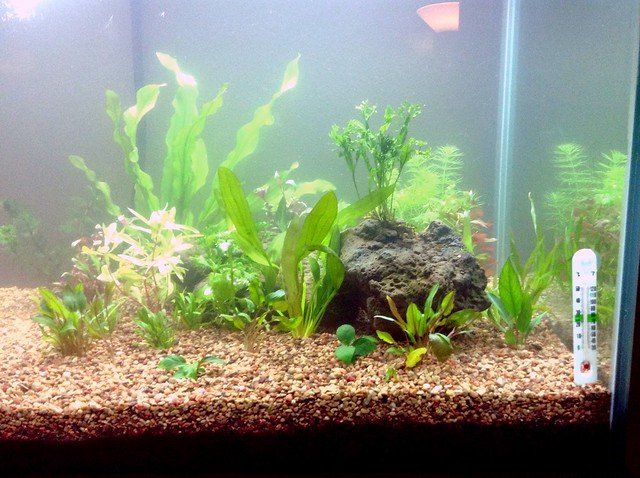
Imagine that you poured a big glass of milk into your aquarium. That’s what gray water looks like.
The water is still transparent, but there is a thick haze that makes everything look fuzzy.
I’ve seen extreme cases where it’s almost impossible to see the fish.
So let’s go over the causes of gray water and how you can deal with it.
Suspect 1 for Gray/White Cloudy Water: New Substrate
If you just added new gravel, sand or soil to your tank, a cloud of dust or detritus might end up in the water column.
Bags of substrate get shifted around, tossed about and just generally abused as they make their way from the manufacturer to the store. All that motion means that the substrate inside the bag rubs against itself and breaks off tiny particles that form a fine dust.
If you don’t rinse the substrate enough, it plumes up in a huge cloud and makes a big mess.
How to Fix Cloudy Water from New Substrate
A lot of times, just having a little patience is all it takes to fix water that’s gotten cloudy because of new substrate. It may only take a few hours, but in some cases, it may take several days.
You can do a 50% water change and try to remove some of the dust.
You can also add super fine mechanical filter media to trap the particles for you. Polishing pads are a great option that can be cut to fit most filters.

Last update on 2024-04-18 / Commissions Earned / Images from Amazon Product Advertising API
How to Prevent Substrate from Clouding Your Water
The single biggest thing you can do to prevent this problem in the future is to rinse your substrate.
What has worked best for me is to put small batches in a bucket and run a garden hose through it until the water comes out clean.
It’s especially important to do this with plant substrates because they can cloud your water to the point that you can’t even see the fish.
It can look like you filled the tank with strong coffee. Not the best look.
Also, you want to be very gentle when you put water into the tank with plant substrate.
Pro Tip: My best results have been with using a hose from the sink on very low flow so it slowly fills the tank up
If you have to use buckets, slowly scoop water into the tank. Yes, it will take forever, but it means less of a mess to deal with.
Suspect 2 for Gray/White Cloudy Water: Bacterial Bloom
If your water has gone milky, and you haven’t just added new substrate, you could be looking at a much more serious problem, a bacterial bloom.
Bacterial blooms happen when there is a population explosion of heterotrophic bacteria (bacteria that need organic compounds as food) in the water column.
You can’t see an individual bacteria with the naked eye. But when there are billions of them, you can actually see the giant swarm of them clouding the water.
These are different from the beneficial bacteria that process ammonia for you. The good bacteria in your filters are autotrophic (can feed on inorganic substances). The heterotrophic bacteria you see in blooms are what causes fish waste to rot and produce ammonia.
Heterotrophic bacteria don’t infect fish and make them sick. Normally, they are present in all aquatic environments all the time, just hanging out in the background. But their numbers can explode when there is a lot of organic waste in the water for them to eat.
This can be caused by:
- Overfeeding – the bacteria feed on uneaten food in the aquarium
- Overcrowding – too many fish for the volume of the tank
- Poor filtration – not enough filtration for your size tank and/or number of fish
- Over-cleaning your filter – cleaning your filter too much and destroying the colonies of beneficial autotrophic bacteria that live in them
- Dead fish in the tank – a dead fish breaking down in the tank can really foul the water
The bad news is, although the bacteria don’t directly make fish sick, they can negatively impact your water quality and that can make your fish sick.
Many people think these bacterial blooms are caused by ammonia spikes, because you often see the cloudy water and raised ammonia levels together.
But the spike in ammonia doesn’t cause the bacterial bloom. The bacterial bloom causes the ammonia spike.
The swarm of bacteria eats up the dissolved organics and puts off tons of waste in the form of ammonia. Very bad news since ammonia is so toxic.
How to Deal with a Bacterial Bloom
Bacterial blooms happen most often when a tank has not built up enough beneficial bacteria to process fish waste.
Here’s how to deal with them.
No Fish in the Tank
If there are no fish in the tank, such as performing a fishless cycle, there’s no need to do anything about the bacterial bloom. Just let it run its course and it will clear up once the heterotrophs eat up the organics and die off.
Fish in the Tank
– Since these bacteria can deplete oxygen in the water, it’s important to increase aeration. Add an airstone or place a powerhead near the waterline to add surface agitation.
– Monitor the ammonia levels each day. Keep testing ammonia and take measures to combat this. Adding Seachem Prime every other day until levels come down can stop fish loss.
– Feed sparingly. Make absolutely sure no uneaten food is left in the tank.
– Perform 50% water changes every other day to help remove organic compounds from the water and substrate.
How to Prevent Gray Water from Coming Back
Your best bet to keep this problem from coming back is to keep up with your aquarium maintenance.
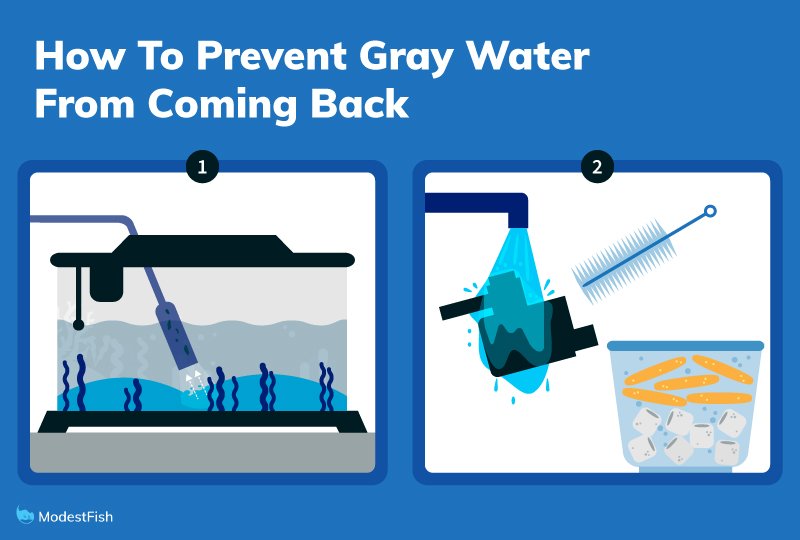
1. Regular Water Changes
Weekly 25%-50% water changes removes organic wastes from your water. Make sure to use a gravel vacuum and get built up gunk out of your substrate.
2. Rinse Out Your Filters Using Tank Water
About once a month, it’s a good idea to clean out your filters. You don’t want to sterilize them, that would kill the beneficial bacteria that you need, but you can rinse out the sludge that builds up over time.
Mechanical media, like sponges and filter floss, can really build up some seriously gross funk. Rinsing and squeezing these out in a bucket of dechlorinated water can remove waste that otherwise just sits and breaks down in the filter.
Check with your filter manufacturer for their recommendations on how to best maintain the model you use.
Pro Tip: Proper filter maintenance not only helps beat back nitrates, but also extends the life of your filter.
Do You Have Yellow/Brown Aquarium Water?
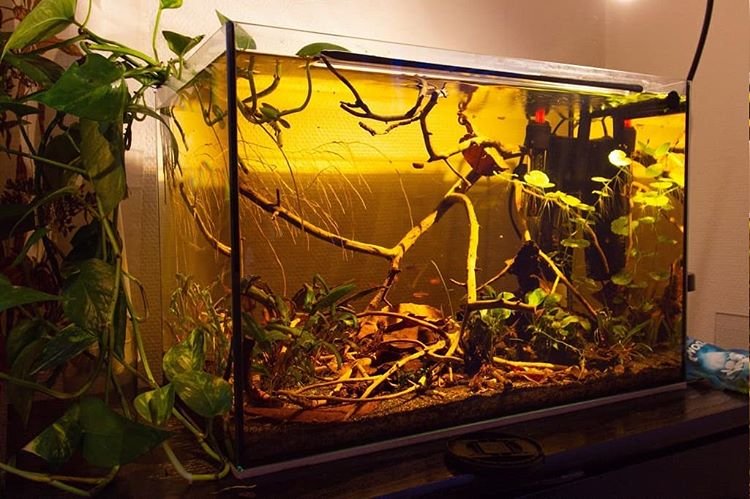
Sometimes, aquarium water can get a yellow/brownish tint to it.
This is caused by tannins in the water.
If you’re not familiar with tannins off the top of your head, don’t panic about it. They will not harm your fish or plants.
In fact, having tannins in your water can be beneficial for species that originate from blackwater environments, like Bettas, killifish and neon tetras.
Tannins are produced by plants as a defense mechanism. They give the plants a strong bitter taste which can help keep insects from eating them. Plus, tannins discourage the growth of harmful pathogens, like bacteria, viruses and fungi.
In an aquarium, the most common source of tannins is driftwood and some areas have tannins in the local tap water.
Some aquarists don’t mind the look of tannins in the water, but many just cannot stand it.
If you’re one of the people who don’t like the look of tannins in your aquarium, there are ways to deal with them.
How to Prevent Yellow/Brown Water
Pre-soak driftwood before placing it in your aquarium.
When I get a new piece of driftwood, I soak it for several days in a bucket or plastic storage tote with salt water. I recommend to mix up a ½ cup of aquarium salt per gallon of hot water.
You should plan on soaking the wood for at least 3-7 days. I know this sounds like a lot of time, but you’ll need to get your driftwood saturated and so it will sink anyway.
And trust me, sometimes even a small piece of driftwood can leach tons of tannins, depending on the kind of wood. You’ll eliminate so many of the tannins if you pre-soak the wood.
If the water starts to look like iced tea, dump it and replace it. You might need to do this several times with large pieces. When the water stays clear for a day or two, then it’s time to put the driftwood in the tank.
Large pieces of driftwood may leach some tannins over time no matter how long you soak them.
Do You Have Green Aquarium Water?
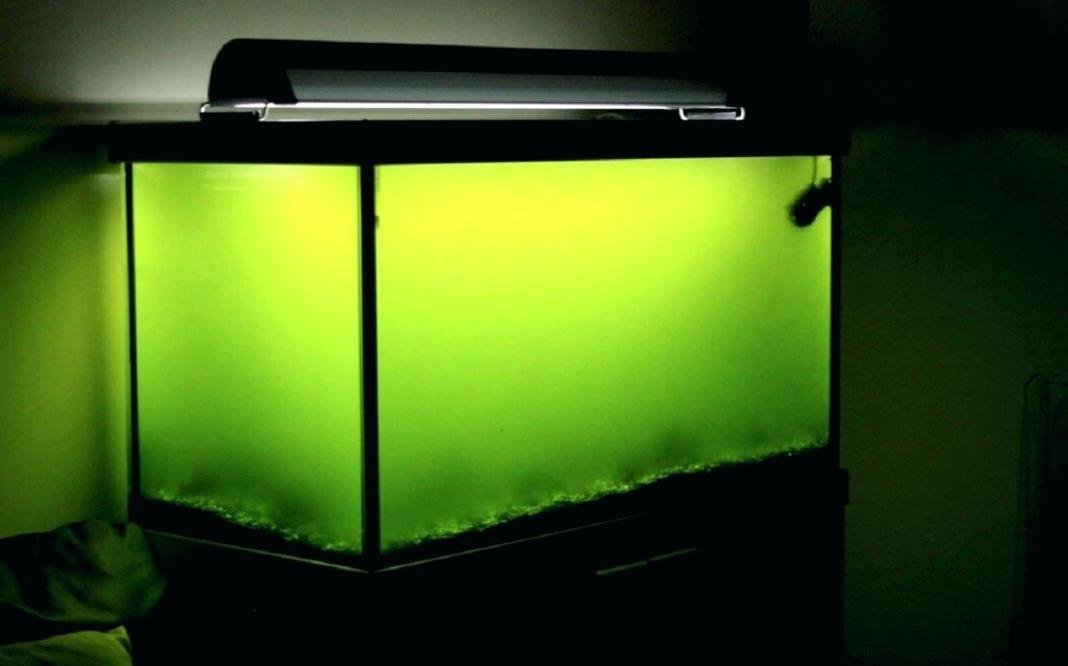
Don’t worry, green water is not harmful to fish, it just looks awful.
Green water looks exactly like it sounds, your water turns bright green, as if you filled the tank up with Mountain Dew.
Green water is caused by an overgrowth of free-floating microscopic algae. Instead of the kinds of algae that coat your glass and decor, this stuff churns around in the water column multiplying like crazy.
There are three key components that cause just about every kind of algae bloom. If you can get a handle on these, you can beat back algae:
- Light – either using lights that are too intense and/or leaving the lights on too long. Too much light is the main cause of 99% of algae outbreaks. Control the light, control the algae.
- Nitrates – nitrates build up in the water column if you slack off on water changes and can make algae outbreaks even worse. Higher nitrates will make algae thicker and more robust. The light is the main cause, but nitrates are the steroids.
Phosphates – this is another nutrient that algae really loves. Once again, the light is the main culprit but high phosphates can help add gas to the fire.
How to Regulate Lighting
Controlling light is usually the easiest way to get rid of green water and keep it gone.
Try to prevent the tank from getting direct sunlight from windows. Algae gets a huge boost from natural light.
Turn the lights off for several days, maybe even a week.
Put the lights on a timer. Run your lights for only 6-8 hours.
How to Reduce and Regulate Your Tank’s Nitrate Levels
There are several ways to help control nitrates and phosphates in your tank.
Don’t Overfeed
Uneaten food breaks down and puts off tons of nitrates and phosphates.
And, if you feed your fish more than their bodies need, the rest just gets passed through as waste. More waste means…you guessed it…more nitrates and phosphates.
You should only feed your fish what they’ll eat in about 30 seconds (2-3 minutes for slow eaters like bettas). Even if they beg for more, they really don’t need it.
Keep Up with Maintenance
Again, keeping up with cleaning your aquarium and filters reduces nitrates. Lower nitrates means less fuel for algae and other microorganisms in your tank.
It’s best to perform a 25-50% water change once a week to remove solid fish waste and nitrates/phosphates.
How to Reduce and Regulate Phosphates
Any organic compound that breaks down in the tank will put off phosphates (PO4): dead fish, dead plant material, uneaten food, fish waste.
Some pH adjustment chemicals are also phosphate based and some fish food companies use phosphate as a preservative.
To control phosphate levels, don’t overfeed your fish, keep up with regular water changes, remove dead fish and plant material from the tank promptly, and don’t use pH chemicals that contain phosphate.
How to Deal with Green Water and Keep it from Coming Back
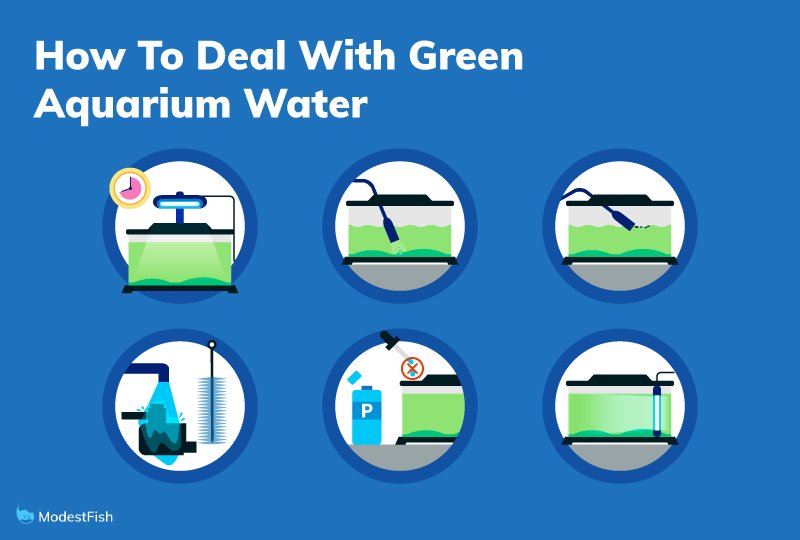
To beat green water, and keep it gone, you’ve got to cut down on the light, nitrates and phosphates in the tank.
- Turn the lights off completely for 7 days
- Do 50% water changes every 3 days, clean the substrate really well while the lights are off.
- Once the algae dies back, add a timer onto your lights so the photoperiod is only 6-8 hours a day
- Monitor feeding closely, and remove any uneaten food.
- Clean out filters.
- Stop using phosphate-based pH additives.
- Add a UV sterilizer to kill algae in the water column.
- Once the water has cleared, water changes can go back to once a week.
- Reducing light, keeping up with your tank maintenance and feeding carefully should keep your water nice and clear.
How to Keep Your Aquarium Water Clear for Good
Every aquarist I know has had to deal with cloudy water at some point.
Bacterial blooms, tannins and microalgae can be a real pain, but no worries, there are ways to get rid of them for good.
More often than not, things like gray and green water are caused by some sort of imbalance in the tank.
Getting back to a better maintenance routine can go a long way towards dealing with these issues and keeping them gone long term.
For me, I’ve always found that spending a little extra time on maintenance means I spend way less time and money trying to fix problems. And that gives me more time to sit back and enjoy my tanks.
I hope you find this article helpful.
I wish you and your fish the very best!

Found your article most helpful. It helped sort out my problem – over feeding. And I will do more water changes.
Really helpful and informative ,thank you Katherine.
Thanks so much..I learned alot from reading ..I will pass it on to my son and friends who now enjoy having fish tanks.GR8 READ 4 PROBLEM SOLVING
Tannins are important for the health of bettas and I actually put Indian Almond leaves in my tank. Your article treats tannins like something bad even though you do say they won’t harm fish but you fail to point out the benefits.
Hi Debra, you are right, tannins can be beneficial. However, this article focuses on how to make aquarium water clear, not betta fish or indian almond leaves. So understanding tannins can color water is what is important for readers in this scenario. Not everyone likes the look tannins create. If you would like to read more on the benefit of tannins from indian almond leaves, you can see our article here focusing on it here https://modestfish.com/indian-almond-leaves/
Thanks for this article because we have our new fish about 5 weeks now but could the water be making him stress?? No matter what I do the water always seems cloudy